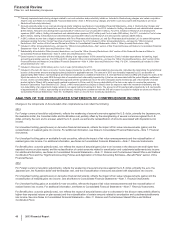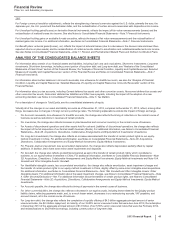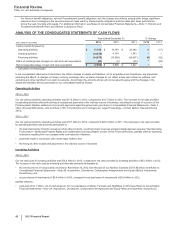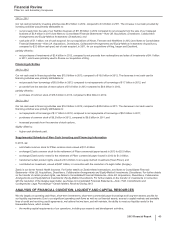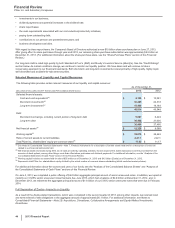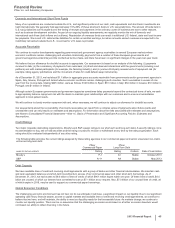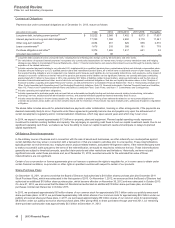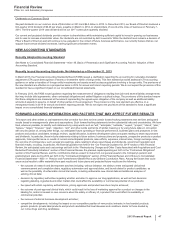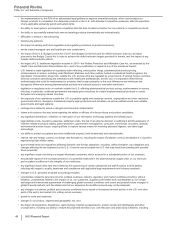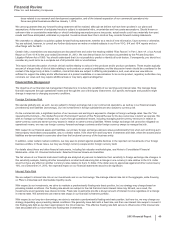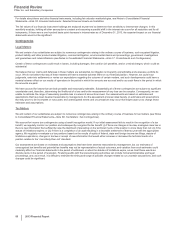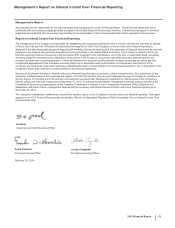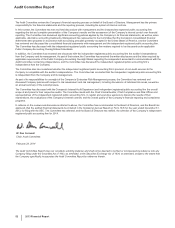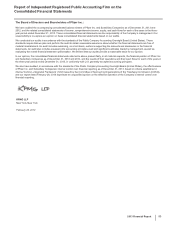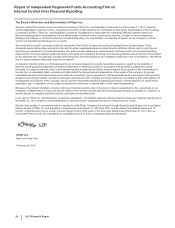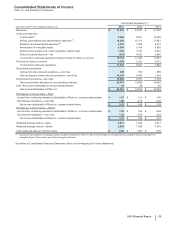Pfizer 2013 Annual Report Download - page 51
Download and view the complete annual report
Please find page 51 of the 2013 Pfizer annual report below. You can navigate through the pages in the report by either clicking on the pages listed below, or by using the keyword search tool below to find specific information within the annual report.
Financial Review
Pfizer Inc. and Subsidiary Companies
50
2013 Financial Report
For details about these and other financial instruments, including fair valuation methodologies, see Notes to Consolidated Financial
Statements—Note 7A. Financial Instruments: Selected Financial Assets and Liabilities.
The fair values of our financial instrument holdings are analyzed at year-end to determine their sensitivity to interest rate changes. In this
sensitivity analysis, holding all other assumptions constant and assuming a parallel shift in the interest rate curve for all maturities and for all
instruments, if there were a one hundred basis point decrease in interest rates as of December 31, 2013, the expected impact on our financial
statements would not be significant.
Contingencies
Legal Matters
We and certain of our subsidiaries are subject to numerous contingencies arising in the ordinary course of business, such as patent litigation,
product liability and other product-related litigation, commercial litigation, environmental claims and proceedings, government investigations
and guarantees and indemnifications (see Notes to Consolidated Financial Statements—Note 17. Commitments and Contingencies).
Certain of these contingencies could result in losses, including damages, fines and/or civil penalties, and/or criminal charges, which could be
substantial.
We believe that our claims and defenses in these matters are substantial, but litigation is inherently unpredictable and excessive verdicts do
occur. We do not believe that any of these matters will have a material adverse effect on our financial position. However, we could incur
judgments, enter into settlements or revise our expectations regarding the outcome of certain matters, and such developments could have a
material adverse effect on our results of operations in the period in which the amounts are accrued and/or our cash flows in the period in which
the amounts are paid.
We have accrued for losses that are both probable and reasonably estimable. Substantially all of these contingencies are subject to significant
uncertainties and, therefore, determining the likelihood of a loss and/or the measurement of any loss can be complex. Consequently, we are
unable to estimate the range of reasonably possible loss in excess of amounts accrued. Our assessments are based on estimates and
assumptions that have been deemed reasonable by management, but the assessment process relies heavily on estimates and assumptions
that may prove to be incomplete or inaccurate, and unanticipated events and circumstances may occur that might cause us to change those
estimates and assumptions.
Tax Matters
We and certain of our subsidiaries are subject to numerous contingencies arising in the ordinary course of business for tax matters (see Notes
to Consolidated Financial Statements—Note 5D. Tax Matters: Tax Contingencies).
We account for income tax contingencies using a benefit recognition model. If our initial assessment fails to result in the recognition of a tax
benefit, we regularly monitor our position and subsequently recognize the tax benefit: (i) if there are changes in tax law, analogous case law or
there is new information that sufficiently raise the likelihood of prevailing on the technical merits of the position to more likely than not; (ii) if the
statute of limitations expires; or (iii) if there is a completion of an audit resulting in a favorable settlement of that tax year with the appropriate
agency. We regularly re-evaluate our tax positions based on the results of audits of federal, state and foreign income tax filings, statute of
limitations expirations, changes in tax law or receipt of new information that would either increase or decrease the technical merits of a
position relative to the “more-likely-than-not” standard.
Our assessments are based on estimates and assumptions that have been deemed reasonable by management, but our estimates of
unrecognized tax benefits and potential tax benefits may not be representative of actual outcomes, and variation from such estimates could
materially affect our financial statements in the period of settlement or when the statutes of limitations expire, as we treat these events as
discrete items in the period of resolution. Finalizing audits with the relevant taxing authorities can include formal administrative and legal
proceedings, and, as a result, it is difficult to estimate the timing and range of possible changes related to our uncertain tax positions, and such
changes could be significant.


